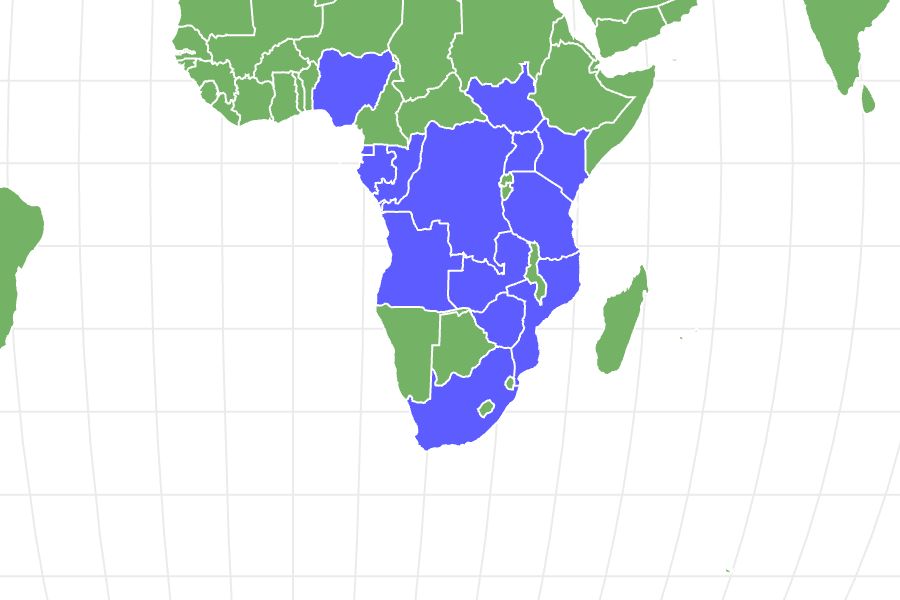Gaboon Viper
Bitis gabonica
Gaboon vipers are the largest vipers in Africa.
Advertisement
Gaboon Viper Scientific Classification
- Kingdom
- Animalia
- Phylum
- Chordata
- Class
- Reptilia
- Order
- Squamata
- Family
- Viperidae
- Genus
- Bitis
- Scientific Name
- Bitis gabonica
Read our Complete Guide to Classification of Animals.
Gaboon Viper Conservation Status
Gaboon Viper Facts
- Prey
- Mammals, ground-living birds and amphibians
- Fun Fact
- Gaboon vipers are the largest vipers in Africa.
- Litter Size
- 20 to 50
- Diet
- Carnivore
- Type
- Reptile
- Common Name
- Gaboon viper, forest puff adder, whisper, butterfly adder, Gaboon adder, swampjack
- Location
- sub-Saharan Africa
View all of the Gaboon Viper images!
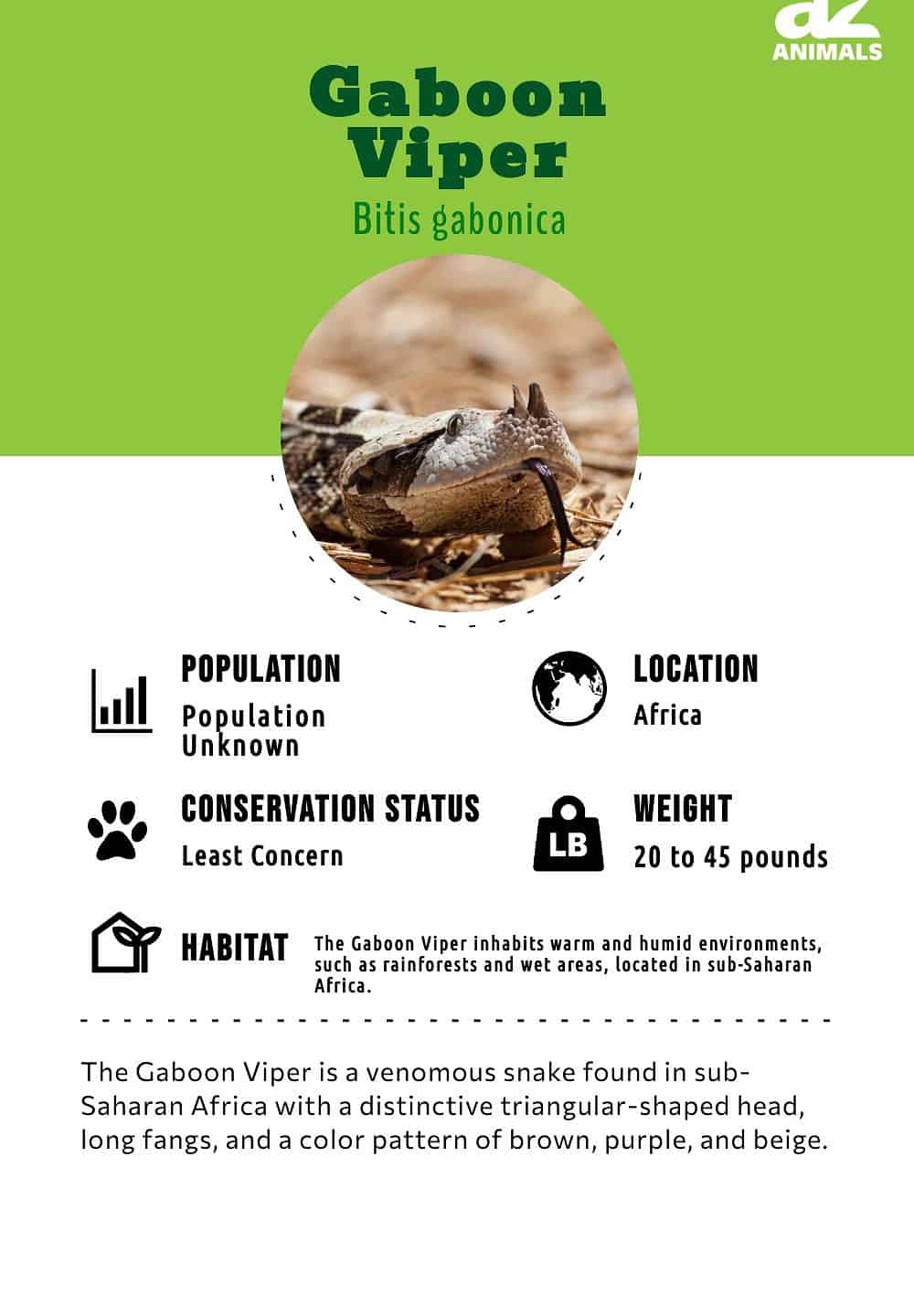
“The Gaboon Viper has the longest fangs of any snake”
This strikingly patterned snake is one of the biggest venomous snakes on earth. That doesn’t so much mean length, as it rarely gets any longer than 7 feet, but weight.
It is a creature of a size that’s pleased to move slowly and is slow to anger, but that should fool no one. The gaboon viper has one of the fastest strikes in the snake world and delivers one of the biggest loads of venom.
Gaboon Viper Amazing Facts
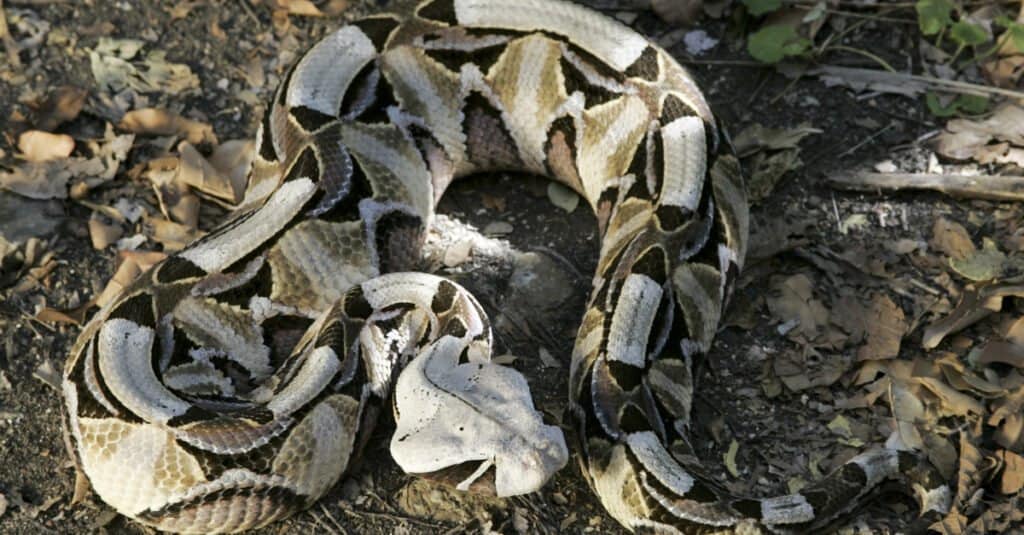
©Stu Porter/Shutterstock.com
Here are five amazing facts about this beautiful, nocturnal ambush predator.
- The gaboon viper is the biggest viper in Africa.
- It delivers the second-largest amount of venom per bite because when it bites it doesn’t let go easily.
- It can have a weight of over 45 pounds.
- Though the viper’s usual diet is made up of small size animals, it has been known to eat a fully-grown royal antelope which is about as big as a toy poodle.
- Fortunately, the gaboon viper is a bit of a slug-a-bed and not very aggressive.
Where To Find the Gaboon Viper
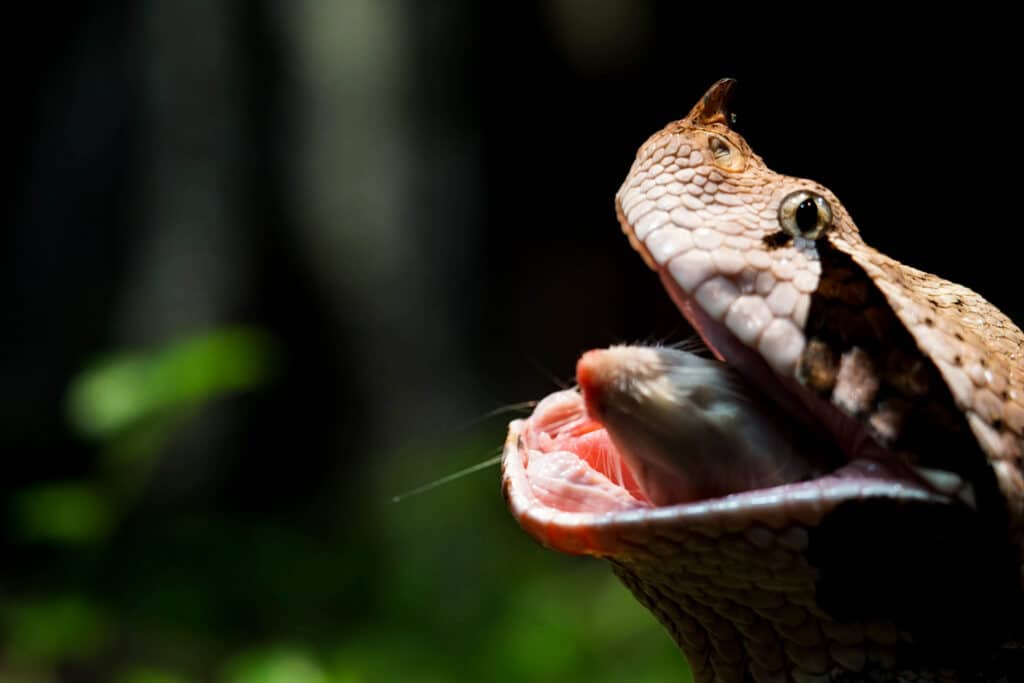
Gaboon vipers inhabit warm and humid environments located in sub-Saharan Africa.
©iStock.com/makasana
Gaboon vipers are found in sub-Saharan Africa in habitats that are moist and warm. The patterns formed by their colorful scales allow them to camouflage in the duff and are an aid in the identification of the reptile.
Evolution and Origins
The vipers dwell on the forest floor and are terrestrial creatures that can be found in wet regions and rainforests in various parts of Central, East, and West Africa.
While the oldest known viper fossils date back to the lower Miocene, molecular studies indicate that Viperidae may have originated much earlier, during the early Eocene.
The Old World was where vipers first emerged, with pitvipers later expanding into the New World and quickly spreading throughout North, Central, and South America.
Being part of the Crotalinae family, the Gaboon Viper is closely related to other species of snakes within this subfamily. Examples of other vipers belonging to this group are Rattlesnakes, Moccasins, Bushmasters, and Asian Lanceheads.
Scientific Name
The snake’s scientific name is Bitis gabonica. The species name refers to the Gabon estuary found in the country of the same name or the northern part of what was then the French Congo.
The Different Types
For a while, scientists believed that the gaboon viper had a subspecies called Bitis gabonica rhinoceros. It was then discovered that B. g. rhinoceros was a separate species, and now it is referred to simply as B. rhinoceros.
Population and Conservation Status
Gaboon vipers are abundant in their native habitat, but their conservation status is listed as vulnerable due to habitat loss.
Appearance and Description
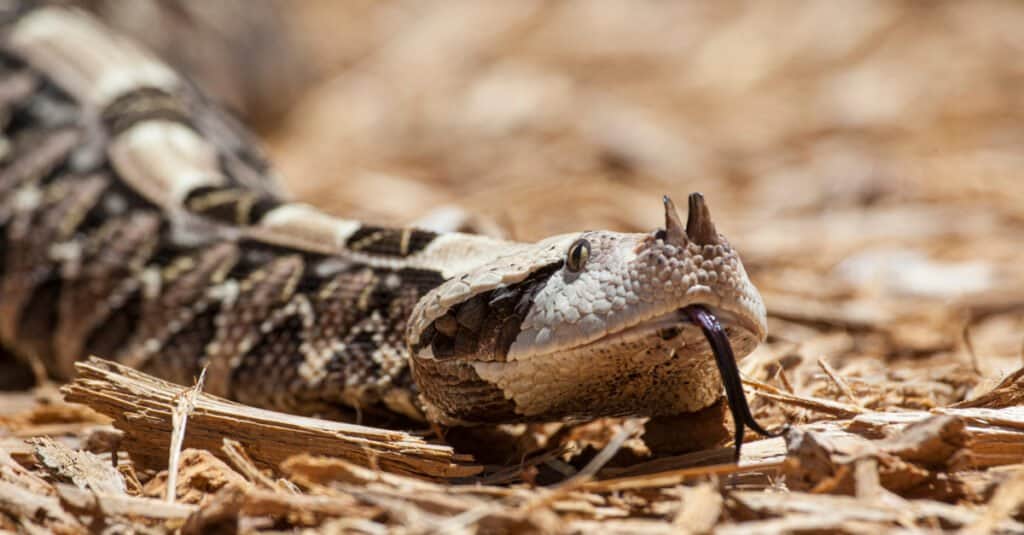
©Danita Delimont/Shutterstock.com
Identification of this ambush predator is easy because no snake looks quite like it. Its upper body is made up of beautiful diamonds, triangles, and hourglasses in neutral colors that mimic the colors of leaf litter. There are bars running down the back in the shape of lozenges. The scales on its back are beautifully keeled, and its belly is whitish and bears black or brown patches. The snake’s neck is narrow, but its head is massive, broad, and shaped like a leaf.
It is white or cream-colored with a thin dark line down the center. Like many members of Bitis, it has horns between its nostrils. There’s a patch of dark brown behind and below each eye, and the eyes themselves are small and have a silvery sheen and cat-like irises.
The snake also differs from others in that its eyes have a surprising range of movement. One eye can look forward while the other looks backward. Though the look of the snake is breathtaking when it is out in the open, its colors and patterns make it very hard to see as it waits for prey among fallen leaves.
Another aid in the identification of the snake is the fact that it is, frankly, fat. The heaviest venomous snake on the African continent, the gaboon viper can have a weight of over 45 pounds. Females are especially hefty. The size of the animal causes it to move slowly, but it only has to move fast when it strikes. When it does strike it holds on.
This is different from other venomous snakes that strike, pull back, and wait for their prey to die. That the gaboon viper has 2-inch long fangs helps it hold on to its dinner. The fangs are so long that they have to be folded back into the reptile’s mouth, and it has to sort of rearrange its jaws to make sure they fit comfortably.
Venom: How Dangerous Are They?
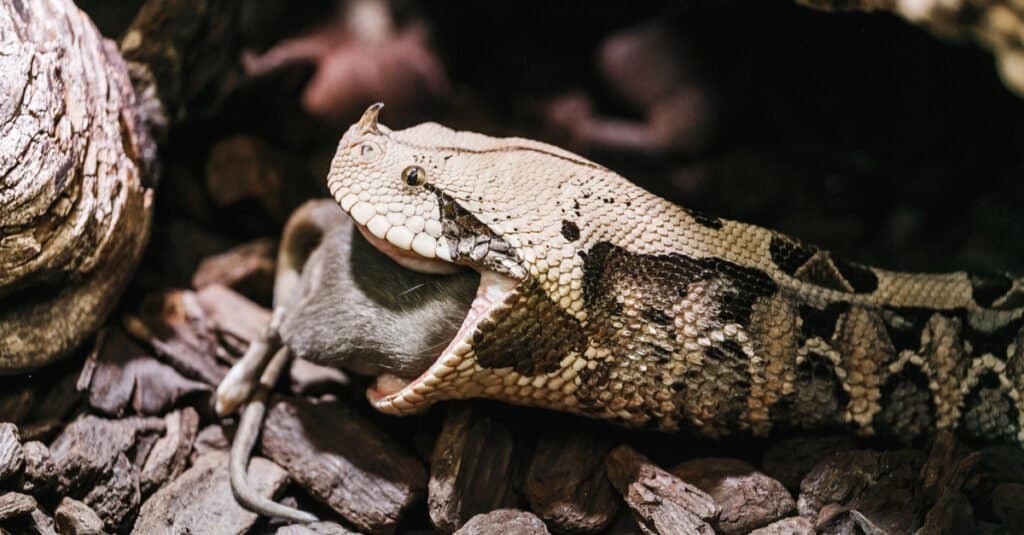
©frantic00/Shutterstock.com
Gaboon viper bites are actually rare because the snake is so laid-back that it takes a lot of provocation to make it actually bite. The reptile prefers to hiss and flattens its head as a warning. But once a person is bitten, time is of the essence. Though the venom itself isn’t very potent, the snake injects a great deal of it.
There is an antivenom available to treat a bite, but it must be given right away. Even then, a limb may need to be amputated because necrosis or bleeding caused by the bite makes it impossible for the wound to heal properly.
Behavior and Humans
Gaboon vipers are nocturnal, which means they are active at night. This is another reason why bites by these snakes are rare.
At sundown, they come out of their hiding place and find a location to simply wait for prey. Then, like an ambush predator, it strikes, holds on to the prey until it at least stops struggling then swallows it whole. Grown vipers have no predators themselves, but younger ones are sometimes taken by brave secretary birds.
The snake most likely mates during the rainy season. Males fight each other for the right to mate, decorously. They’ll strike with their mouths shut and take breaks between rounds. The fight ends when the winner pins the loser’s head to the ground and raises his own.
Female gaboon vipers are gravid for about seven months, then can give birth to anywhere between 20 and 50 babies at one time. After that, she takes no more care of them. Though biologists aren’t entirely sure of the viper’s lifespan, some believe the lifespan can be as long as 20 years.
Like other snakes, gaboon vipers are helpful to humans because they get rid of pests. However, their venom makes them dangerous. Despite this, they are often used as bushmeat.
View all 170 animals that start with GGaboon Viper FAQs (Frequently Asked Questions)
Are gaboon vipers venomous?
Gaboon vipers are quite venomous.
How do gaboon vipers hunt?
Like other vipers, Bitis gabonica is readily able to pick up the chemical and heat signatures of its prey and might follow it for a while after dark. But mostly it lies in wait in one location till potential prey wanders along. Then it strikes, and unlike other venomous snakes, holds on until the prey is immobilized or dead.
Are gaboon vipers aggressive?
Gaboon vipers are not very aggressive and don’t seem to mind being handled to a point.
Where do gaboon vipers live?
Locations where Bitis gabonica lives include Nigeria, Tanzania, Kenya, Uganda, and the Central African Republic.
What do gaboon vipers eat?
The diet of the gaboon viper is made up of small mammals such as rodents and lagomorphs. They also eat birds that live on the ground such as francolins. Toads and frogs are also part of the snake’s diet.
What is a gaboon viper?
The gaboon viper is a highly venomous nocturnal snake that lives in sub-Saharan Africa and is a member of the Bitis genus.
How deadly is a gaboon viper?
The bite of this viper delivers a great deal of venom because their venom glands are very large, and they tend to hang on. The only reason more people are not killed by these snakes is that they are very tolerant of being handled or even stepped on, to a point. Antivenom is also available to treat gaboon viper bites.
How much does a gaboon viper cost?
Baby gaboon vipers can be had for about $100, but buying one is not recommended.
Where can I buy a gaboon viper?
Gaboon vipers can be bought over the internet if you must buy one.
What happens if a Gaboon viper bites you?
If the viper bites you you must seek medical attention immediately and be treated with antivenom in order to save your life. The symptoms of a bite are terrible pain, swelling and blistering where you were bit, incontinence, clumsiness, swollen eyelids and tongue, and convulsions that lead to unconsciousness. People have been known to die even after they’ve been treated because their blood can no longer form clots.
Are gaboon vipers good pets?
Gaboon vipers may be docile, but they are definitely not good pets. An owner of this snake only needs to be bitten once to learn that keeping it as a pet was a really bad idea.
Has anyone survived a Gaboon viper bite?
People have survived the bite of a gaboon viper, but many have had to have limbs amputated to do so.
How fast can a Gaboon viper strike?
Though the snake is usually sluggish, it can strike with amazing speed. Its head can move at between 175 to 200 miles per hour.
What is the difference between a Gaboon viper and a king cobra?
One difference between gaboon vipers and king cobras is that gaboon vipers are much shorter and heavier bodied than king cobras. Further, gaboon vipers live in select parts of Africa, whereas king cobras are native to India and Southeast Asia. One more key difference is their coloring – king cobras are solid colored, while gaboon vipers have complex patterns to help them blend in with their surroundings.
What is the difference between a Gaboon viper and a black mamba?
The most significant differences between a Gaboon viper and a black mamba are their size, venom, and morphology.
The Gaboon viper is a large snake that can measure 7ft and 45lbs, has a thick body and wide, leaf-shaped head with two horns, and injects the most venom of any snake per bite. The black mamba is a thin, long snake measuring 4.5lbs and up to 14ft, has one of the most potent neurotoxic venoms on the planet, and has a distinct black mouth.
What's the difference between a rattlesnake and a Gaboon viper?
The greatest differences between a Gaboon viper and a rattlesnake are their morphology and location.
Gaboon vipers are venomous snakes in sub-Saharan Africa, known for their broad, leaf-shaped head, horns between their nostrils, and thick, heavy bodies. Rattlesnakes are endemic to the Americas, possess a triangular head, have a thick body, and have a distinct rattle on the end of their tail that is used as a defensive warning.
What are the key differences between a gaboon viper and a green mamba?
The key differences between the gaboon viper and the green mamba are in their size, appearance, lifespan, and behavior.
What is the difference between a Gaboon viper and a rhino viper?
The key difference between the Gaboon viper and the rhino viper is that Gaboon vipers are significantly larger and heavier than rhino vipers.
Read about the other differences here.
Who would win a fight between a gaboon viper and mongoose?
A mongoose would win a fight against a Gaboon viper. The Gaboon viper is too easygoing and slow for its own good. It is a docile snake unless it is hunting or fighting other males during the breeding season. Mongooses can be very hostile, so they would charge into this battle prepared to overwhelm the otherwise slow-moving creature.
What are the differences between a bushmaster and a Gaboon viper?
The key differences between the bushmaster and the Gaboon viper lie in their size, behavior, hunting style, and family.
Thank you for reading! Have some feedback for us? Contact the AZ Animals editorial team.
Sources
- Field & Stream, Available here: https://www.fieldandstream.com/gaboon-viper-snake-you-cant-see/
- Kidadl, Available here: https://kidadl.com/animal-facts/gaboon-viper-facts
- Wikipedia, Available here: https://en.wikipedia.org/wiki/Gaboon_viper
- ITIS, Available here: https://www.itis.gov/servlet/SingleRpt/SingleRpt?search_topic=TSN&search_value=634953#null
- Smithsonian National Zoo, Available here: https://nationalzoo.si.edu/animals/gaboon-viper
- IUCN, Available here: https://www.iucnredlist.org/species/13300893/13300904
- Fresno Chaffee Zoo, Available here: https://www.fresnochaffeezoo.org/species/gaboon-viper/
- Reptile World Facts, Available here: https://medium.com/@reptileworldfacts/top-10-gaboon-viper-facts-1ad2c280f81f
- PubMed, Available here: https://pubmed.ncbi.nlm.nih.gov/6395443/

